Oklahoma's Executive Nomination Crisis: Exposing the Endless Cycle of Corruption
Another missed opportunity for our elected leaders to demand real answers from the man who currently controls BILLIONS of federal and state tax dollars
On May 21st, 2024 at 10:45 am in the State Capitol, Mr. Tim Gatz’s Executive Nomination as the Executive Director of the Oklahoma Department of Transportation (ODOT) was brought before the Senate Aeronautics & Transportation Committee for discussion and vote.
Watch the proceedings starting at 10:54:44 here: Senate Committee on Aeronautics and Transportation Executive Nomination Hearing
But be warned. It’s a disgusting display of what was supposed to be an authentic, credible nomination hearing for the Executive Director of the Oklahoma Department of Transportation; instead, it turned into another rubber stamp committee meeting in spite of Senators Mary Boren and Cody Rogers attempting to bring up legitimate questions and concerns for their constituents. The Senate Transportation Committee Chair, Senator Haste, interrupted Senator Boren several times to stop her questioning.
Senators Boren and Rogers attemped to ask questions about the ODOT’s billion dollar budget, the way in which they purchase property or their frequent deviance from their approved 8-year construction plan.
They weren’t given any satisfactory answers.
I watched the hearing and recorded any committee question with the corresponding timestamp, although I did not transpose Mr. Gatz’s answers for two reasons; 1. He rarely answered any of them directly and his answers contained a bunch of circular logic nothing-burgers, and 2. I can’t stand listening to the transportation cartel blatantly side-stepping the truth.
However, if you are interested in any of the topics he was questioned about, I encourage you to go to the relevant timestamp in the hearing using the slider at the bottom and listen. The timestamp is located at the bottom right of the screen.
Senate Transportation Committee Hearing Recording
Committee Questions During Hearing
Senator Boren question: Timestamp 10:57:06: Ask about the achievements with the train system, out toward Cushing, can you explain that project has been prioritized and who is the contact within the Department of Transportation? Storage area where we transport oil from along the rail line - SOONER SUB LINE.
Gatz reported that ODOT sold the SOONER SUB line (97.5 mile rail line = $75 million) in 2014 and dumped the proceeds of that sale back into rail crossing safety.
I think Senator Boren was trying to get at how ODOT views passenger rail travel and how they are leveraging federal funds to help revitalize rail travel in Oklahoma, but Gatz wouldn’t touch that with a 10-foot pole.
Senator Boren question, Timestamp 10:59:45. Can you tell me the point of contact within ODOT that is over rail?
Senator Boren question, Timestamp 11:01:15. What is the budget breakdown between state, federal and tribal?
Gatz gave a generic answer, but NEVER mentioned the tribal contribution to projects. He was not asked a follow up.
Senator Boren question, Timestamp 11:02:20: My question is about the BoR approval process in that that approval wasn’t secured before the ACCESS plan was announced, and that authorization was withheld.
Chairman Haste interupts Senator Boren, Timestamp 11:03:13. Is this related to ODOT? We need to stay focused on the Department of Transportation.
Senator Boren rephrases question, Timestamp 11:03:50: Could you explain the decision making process……. as the Transportation Director and how organizations like the cities, counties, ACOG, tribes, elected officials and the Bureau of Reclamation should be included during the development of the plan and not after the plan is announced?
Gatz pontificates here and really says nothing.
Senator Rogers question 11:07:26: How does [inflation] affect the ODOT 8-year construction plan moving forward?
Senator Rogers follow up question 11:09:35: In my District, I have the I44 and 75 corridor, we call it Stonehenge, you know, bridge columns up in the air. When is that going to hit the 8-year plan?
Senator Boren Question, Timestamp 11:11:37: Question: Andy Alligators was purchased for the Indian Hills Bridge over I-35 project (JP-29016(09)) to the tune of $6 million dollars. Triad Design’s study included four alternative designs for the bridge project, none of which included Andy Alligator’s property within the right of way take. What was your role in approving the acquisition of this parcel, and why was an “Authority Order used? Do you feel this was a good use of taxpayer dollars?
(This graphic is provided so you, the reader, understand the significance of this line of questioning).
Does ODOT frequently acquire property that is not necessary for a project?
Gatz never directly answered this and talked about how Authority Orders don’t run through OMES and that they often use “Advanced Aquisitions” to purchase properties. Authority Orders refers to how the transactions get processed and Advanced Aquisitions refers to the timing of the purchase in relationship to the typical project process timeline.
He did not directly answer why they bought Andy Alligators and did not talk about how it wasn’t in the direct right-of-way. He did not answer how it was budgeted for. He did not answer how ODOT could purchase “Advance Aquisitions” that aren’t budgeted for in the 8-year construction plan. He never answered why those eight properties were bought so early in the planning process, which really has no precedent.
You might remember that I talked about the Indian Hill Interchange project in a previous substack post. The ODOT acquisitions of the EIGHT (8) properties shown below in RED cost a total of $16,276,327 and at the time of these purchases, this project was NOT included in the 8-year ODOT construction budget. So why did ODOT purchase these properties years in advance of their proposed interchange project before it was even budgeted for?
Follow up questions for Mr. Gatz (by Cerato): How can ODOT use taxpayer money to purchase land that isn’t within their project proposed right-of-way and isn’t budgeted for in their 8-year construction plan? Did they mis-read their proposed plan specifications? Where did the money come from? According to your own polices, properties shouldn’t have been purchased until much later on in the process. If resources are so tight, why wasn’t that $16 million used to fix the deadly intersections along the rural roads in southeastern Oklahoma, for example?
Gatz won’t answer. Gatz will never answer. No one will answer. It remains a mystery.
Follow up by Senator Boren, Timestamp 11:14:14. So that happened in June 2021, and then the ACCESS program was revealed to the public in February 2022.
Interupted by Haste at 11:14:25: Um, Senator, I believe that the ACCESS plan is primarily OTA, so we need to stay on ODOT.
Reword by Senator Boren: I understand that you will be responsible for communicating with the public in the future, correct?
Senator Boren Question, Time Stamp 11:15:15: In the perfect world, how do you see, especially after everything that has happened after you led multiple transportation organizations, how do you see the timeline in consulting ACOG, cities, counties, as plans are being developed so that they are informed and give feedback on the front end, instead of finding out about it through press releases, ribbon cuttings and newspapers.
Senator Haste bullying Senator Boren, Timestamp 11:17:00: Senator Boren I just want to ask, because again this is totally related the the department of transpotation, that’s his only only role at this part, and I just wanted to know if this meandering line of questions is leading at any moment to a salient point, cause again, I want to keep us focused on the Department of Transportation, not into any other areas.
He interupts Senator Boren again and then insinuates that Gatz is A-OK because he HIMSELF has worked with the Director for a number of years.
Give me a break.
Senator Boren Question, Timestamp 11:19:42: What strategies in light of everything that has happened do you have in place to restore public trust in parts of Oklahoma where the department of transpotation is in a trust rebuilding phase. What does that look like to you, and what could we expect from you regarding that redemption and rebuilding trust?
Gatz pauses and says “I’m not understanding….” and then Senator HASTE seemingly jumps to his defense and says (Timestamp 11:20:14) “Well and I just want to again, I’m sorry Senator, alot of what you are referring to is related to the Turnpike Authority and not the Department of Transportation, so if we can, it needs to stay totally relevant to the Department of Transportation, then if not, then we need to move on.
Senator Boren again brings up the ODOT Indian Hills aquisitions and then Senator Haste interjects a question, “Related to acquisitions, what is the percentage that actually ends up in court?
Gatz replies somewhere between 10-15%.
That number needs to change. More people need to take the OTA to court, because as recent court cases have shown, their initial offers are ALWAYS significantly low.
Senator Boren question, Timestamp 11:24:00: I guess you’ve heard about NIMBY, Not in My Backyard, when progress or development happens, that the people that complain about it are labeled as NIMBY. How do you see the best practice in dealing with that concern when just don’t want it in their community and what processes in place that you use regularly to ensure that the plans and the vision for transportation is needed for the whole state?
Senator Cody Rogers, Timestamp 11:26:36: Going back to the property right of way, don’t you guys sell the surplus property you don’t use anymore?
Listen to Gatz bloviate on this topic. Sheesh.
This was the end of the Senate Transportation Committee Hearing questions. A vote was taken and Mr. Gatz was recommended to move forward in the nomination process to the full Senate by a vote of 8-1, with Senator Mary Boren being the lone naye vote.
Thanks to Senator Boren
Thank you again to Senator Mary Boren for attempting to get answers for her constituents and asking for REAL answers about how Oklahoma and Federal Tax dollars are spent on roadways and how the transportation policies and planning exercise include municipal, city and citizen input early in the process.
I think these nomination hearings should be taken a lot more seriously by everyone on the committees. They should all be briefed and have meaty questions ready to go and DEMAND actual answers - not letting the nominee blow hot air about nothing. The nomination process should not be assumed to be a rubber stamp.
Here are some of the additional questions that folks had. The amazing amount of questions regarding the OTA’s nonsense make it even more apparent that ONE DUDE shouldn’t serve in MULTIPLE TRANSPORTATION RELATED STATE OFFICES.
What questions do you have that aren’t on this list? Send them to me and we will add them to the list.
Additional Questions for Mr. Tim Gatz
GENERAL:
1. Background and Qualifications:
Given your degree was in landscape architecture rather than engineering, how do you believe that background prepared you for the technical and logistical challenges of running the Department of Transportation?
How do you respond to concerns that your educational background may not have provided the necessary expertise in transportation planning and infrastructure management?
2. ACCESS Okla. Turnpike Extension Plan Controversy:
From the standpoint of your position as Director of ODOT, can you explain the decision-making process behind the ACCESS OK turnpike extension plan and if and how public input was considered?
Why did you allow that plan to go forward to a vote of the Oklahoma Transportation Commission in July of 2022 for an approval vote? Were you given any information from the OTA that made you comfortable that they were following the letter of the law?
As the director of of ODOT, who is is required to follow federal regulations regarding public input and notification on proposed projects, how do you justify the lack of public meetings and transparency in the planning stages of the turnpike extension project?
What measures will you take, if any, to ensure greater transparency and public
engagement in future projects?
3. Environmental and Legal Issues:
What actions are you taking to address and rectify the concerns raised about the potential bypassing of environmental laws during your tenure?
Can you elaborate on the specific instances where laws might have been
overlooked in the planning and execution of transportation projects under your leadership?
4. Resignation from OTA and Dual Roles:
How do you respond to criticisms regarding potential conflicts of interest from holding dual roles as Secretary of Transportation and Executive Director of the Turnpike Authority and the Executive Director of ODOT?
As the Executive Director of ODOT, did you ever feel coerced into looking the other way or engaging in something on an OTA project or issue that you did not feel comfortable doing?
What steps will you take to ensure that such conflicts do not arise in the future
and that duties of both agencies are performed impartially?
5.Public Trust and Accountability:
What strategies do you have in place to rebuild public trust in the Department of Transportation following the controversies and legal issues that have arisen from ODOT and OTA being directed by the same person?
How will you ensure that the Department operates with greater accountability and transparency moving forward?
6.Professional Experience and Track Record:
Could you discuss specific achievements or projects during your tenure that demonstrate your capability to lead the Department of Transportation effectively?
How do you plan to apply lessons learned from past controversies to improve the operations and reputation of the DOT?
7.Ethics
In your previous position as Director of the OTA and current position as Director of ODOT, are you required to complete any ethics disclosures? If not, how do you maintain an institutional culture of compliance and limit the risks of financial misconduct at these agencies?
Have you ever accepted any gifts from OTA or ODOT vendors or contractors? Have you ever attended sporting events, or accepted tickets to sporting events from ODOT or OTA vendors, associates or contractors? If so, were these gifts disclosed?
LAWSUIT CHALLENGING THE OPINION THAT GATZ CANNOT HOLD MULTIPLE STATE GOVERNMENT POSITIONS:
1. Conflict of Interest Concerns:
Mr. Gatz, how do you address concerns that holding multiple positions within
state government might create conflicts of interest or dilute a persons effectiveness in each role?
2. Legal Merit of the Lawsuit:
The Governor is suing the AG over his opinion that one man cannot serve in multiple state offices. Do you believe that the lawsuit challenging the Attorney General’s opinion has merit?
3. Impact on Governance:
How do you respond to the argument that allowing one individual to hold
multiple leadership positions could undermine the checks and balances within state government?
4. Public Perception:
Given the controversy and the lawsuit, how do you plan to assure the public that when you held multiple roles, you were acting in the best interest of the state and it did not affect the transparency and accountability of your actions while holding three transpotation positions?
Now that you hold only one office and control only one pot of money that has federal oversight, how will that change the way in which ODOT allocates their funds and approaches their 8-year construction plan?
5. Operational Efficiency:
Do you believe that your ability to effectively manage the responsibilities of both the Oklahoma Department of Transportation and the Oklahoma Turnpike Authority was compromised when you held both of these roles? If not, can you provide examples of how you have effectively managed both roles concurrently?
6. Financial Implications:
What are the financial implications of this lawsuit for the state? Do you believe that this legal battle is a prudent use of state resources?
7. Past Precedents:
Are there any past instances in Oklahoma or other states where a similar situation occurred and was resolved in favor of allowing one individual to hold multiple state roles?
8. Governance and Accountability:
How did you ensure governance and accountability standards were maintained while holding multiple high-level positions? What mechanisms were in place to monitor and evaluate your performance in these roles?
What power does the Oklahoma Transportation Commission (OTC) have over the Executive Director of ODOT? What power does to the OTC hold over the OTA?Can the OTC recommend removal or hiring of an executive director or is that a Governor only role? Can the OTC quash an OTA project?
STAN WARD’S DEPOSITION IN THE OPEN MEETING ACT CASE REGARDING ACCESS OKLAHOMA PROJECT
1. Timeline and Early Discussions:
You testified during your deposition in the Open Meeting Act lawsuit that discussions regarding a 15-year, long-range plan began some time before the February 22nd, 2022 public announcement. I want you to clarify the timeline of when the Turnpike Authority began work on what later became known as ACCESS Oklahoma. Specifically, you testified that “If you’re talking in the context of ACCESS Oklahoma as named, probably within 30 or 45 days. If you’re talking about in the context of a 15-year, long-range plan, some time in advance of that.” When exactly did these discussions start, who authorized them and why wasn’t any of it divulged to the public until the 2/22/22 ACCESS rollout OTA Board meeting?
2. Public Disclosure and Communication:
Given the significance of the ACCESS Oklahoma plan, why was there no mention of ACCESS Oklahoma or the Kickapoo Turnpike Extensions in the December 7, 2021, and January 25, 2022, agendas and minutes? You acknowledged, “I don’t believe that the Kickapoo Turnpike Extension is mentioned in the context of the agenda.” How does this align with the principles of the Open Meeting Act, which emphasizes transparency and public awareness or statements by you that you greatly value transparency with the public?
3. Involvement of Governor Stitt:
You mentioned discussions with Governor Stitt ‘very early on’ regarding the ACCESS Oklahoma plan, stating, “The transportation needs of the State of Oklahoma in the context of discussion with the Governor.” Can you provide more detail on these early conversations, including dates and specific topics discussed?
4. Public and Stakeholder Engagement:
It appears that several city managers, county commissioners, and other officials were aware of the ACCESS Oklahoma plan prior to its public announcement on February 22, 2022. How were these individuals informed, and why was this information not disseminated more broadly to the public, particularly to property owners who might be affected?
Are there any other local politicians besides Representative Sherri Conley who the OTA bought land from in connection with the Kickapoo Extensions or ACCESS plans generally?
5. Communication and Transparency:
You have stated that information about the ACCESS Oklahoma plan was shared with certain stakeholders before the public announcement. How do you justify this selective communication in light of the Open Meeting Act’s requirements for transparency?
6.Potential Perjury
In your sworn deposition in the Open Meetings case, you stated that planning for the ACCESS Oklahoma turnpike projects began in December 2021, in preparation for the February 2022 public announcement.
From sworn deposition:
“The work that was started at the December 7th [2021] meeting, continued in the January [2022] meeting, prepared us for the February [2022] meeting.”
Yet on August 23 2021 the OTA finance director sent an email to Michael Newman of Hilltop Securities specifically mentioning “new turnpikes.” (Emails gathered from Open Record Requests)
You accepted a calendar invitation for a phone call with Mr. Newman shortly after, presumably to discuss the financing of these new turnpikes.
Were you truthful in your sworn deposition about the time line of ACCESS turnpike planning?
USBR DENIAL TO USE FEE TITLE LANDS
1. Denial of Authorization by USBR:
As the Director of ODOT, when you are planning projects that may impact federally controlled lands, do you seek permission before, during or after public announcement of a project? Are the federal “stakeholders” brought into the fold early on in the process? What is ODOT’s policy on involving federal landowners in state transportation plans?
As the Director of ODOT, in your close working capacity with OTA, can you confirm whether or not the U.S. Bureau of Reclamation (USBR or BoR) provided authorization for the OTA to cross the Lake Thunderbird watershed area with the proposed ACCESS Oklahoma turnpike routes at the time the ACCESS Oklahoma routes were initially prepared?
2. Authorization and Planning:
Is it typical for transportation agencies to spend money on designing routes prior to obtaining federal, state, municipal or city permission to cross lands? When should the planning process turn into the designing process?
How much money did the OTA spend on planning and designing routes for
ACCESS Oklahoma before being denied access cross BoR fee title lands? Is this a typical occurrance?
3. Communication and Coordination:
Can you explain why the OTA did not secure advance authorization from the
USBR for crossing the Lake Thunderbird watershed area before spending substantial sums on planning and engineering? Specifically, how do you justify these expenditures having been made without confirmed route approvals? In other words, how much money was wasted in pursuing the development of the route by not grasping that it ran through the USBR fee title Lake Thunderbird
watershed lands and easements such that its denial was virtually assured?
4. Impact of USBR Denial:
In light of the USBR’s formal denial on January 17, 2023, how has the OTA
addressed the need to alter the proposed turnpike routes? What are the financial and logistical implications of this denial for the ACCESS Oklahoma project?
5. Public Disclosure and Transparency:
Considering the USBR’s objection and the subsequent need for route modifications, how has the OTA communicated these significant changes to the public and affected property owners? Were there any initial notifications that became invalid due to these route changes?
6. Plans and Actions with USBR Subsequent to its Rejection of Your Proposed Route
During the OTA Feb. 2024 Board of Directors Meeting, then Chief Engineer TJ Dill (now OTA Deputy Director) announced that OTA would be “reengaging OTA staff and the ACCESS Program Manager (Poe & Assoc.) later this year to address the BoR’s denial and to “reassess and evaluate any changes to the proposed location of the South Extension and the East-West Connector Turnpikes.”
What did Mr. Dill mean by this? Is the OTA lobbying or attempting to lobby the BoR to relax its stance? Has the OTA worked with Poe & Associates or their industry lobbyist, Bobby Stem to try to lobby the BoR to change its position?
I understand that at some point in the past, either as part of Driving Forward or in the ACCESS planning, there was a route design that would have run along the east side of Lake Thunderbird. When and why were such plans abandoned and, in
light of the BoR decision, has any thought been given to resuscitating such plans? And if not, why not?
PIKE OFF OTA (501 c4) and Oklahomans for Responsible Transportation, Foundation (501 c3) are leading the charge in legal injunctive avenues and legislative reform and they could use your help. They are trying to dismantle a corrupt Goliath within our state and are doing a great job. Be part of the solution!
www.pikeoffota.com
Join us on Facebook as well.




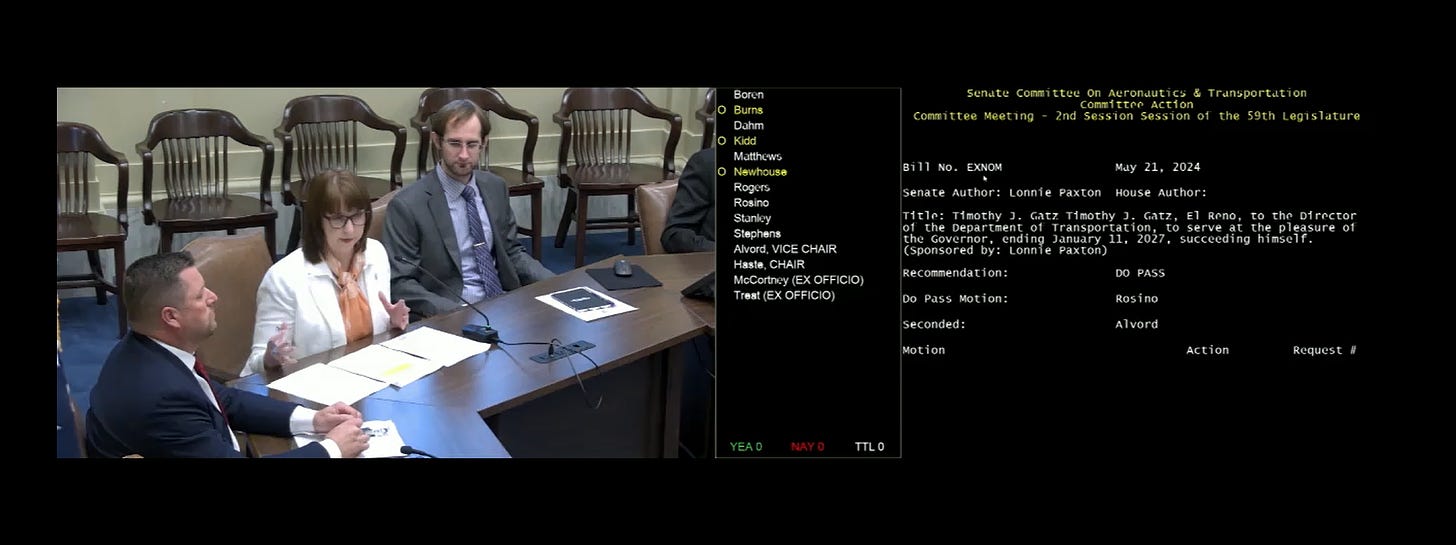
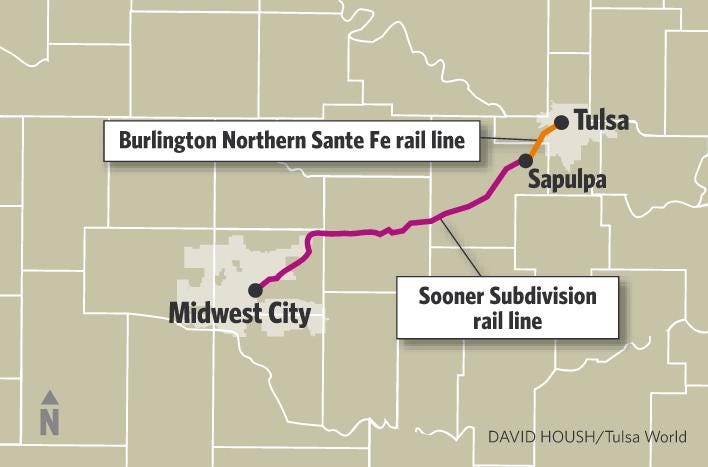
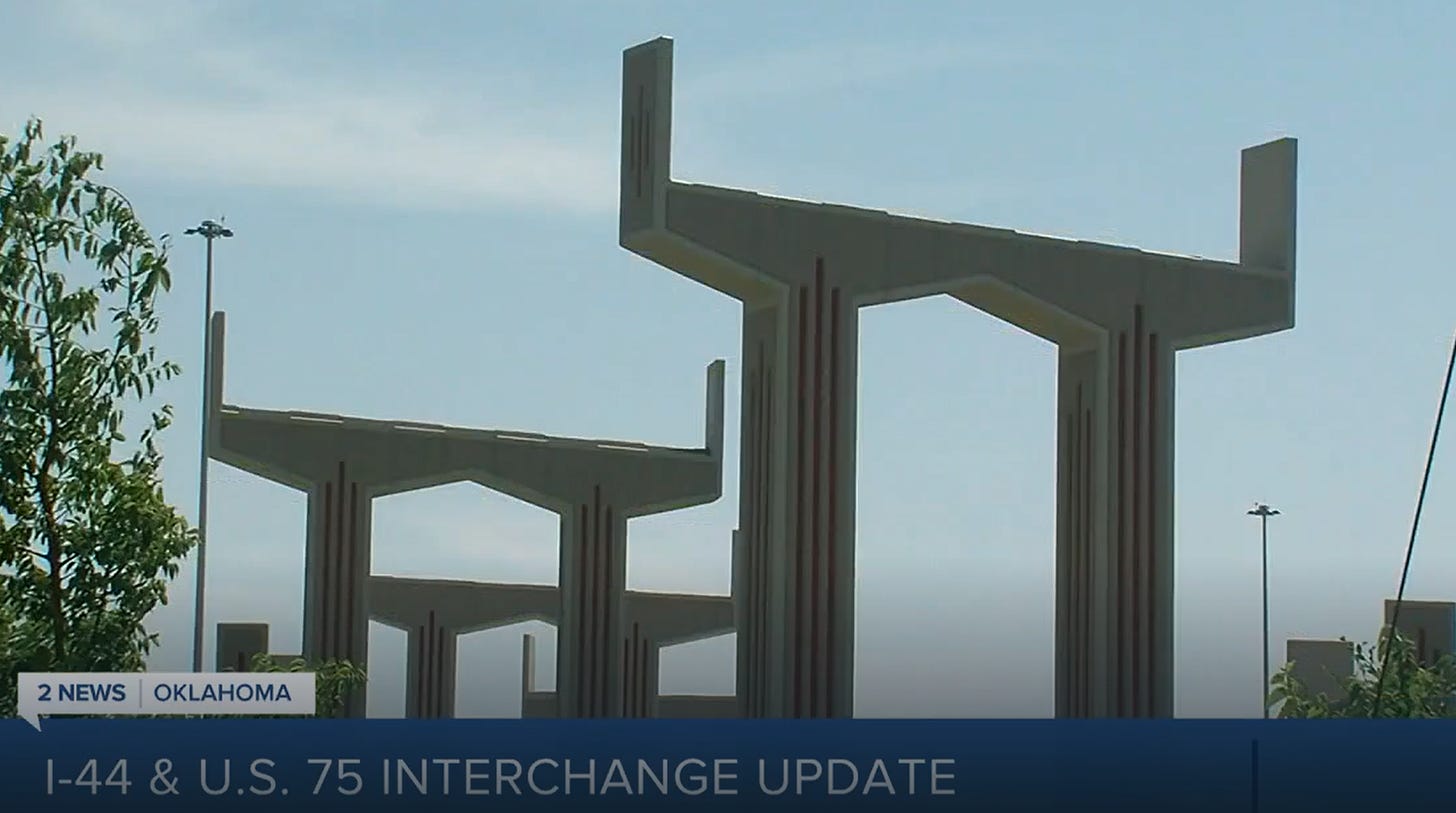
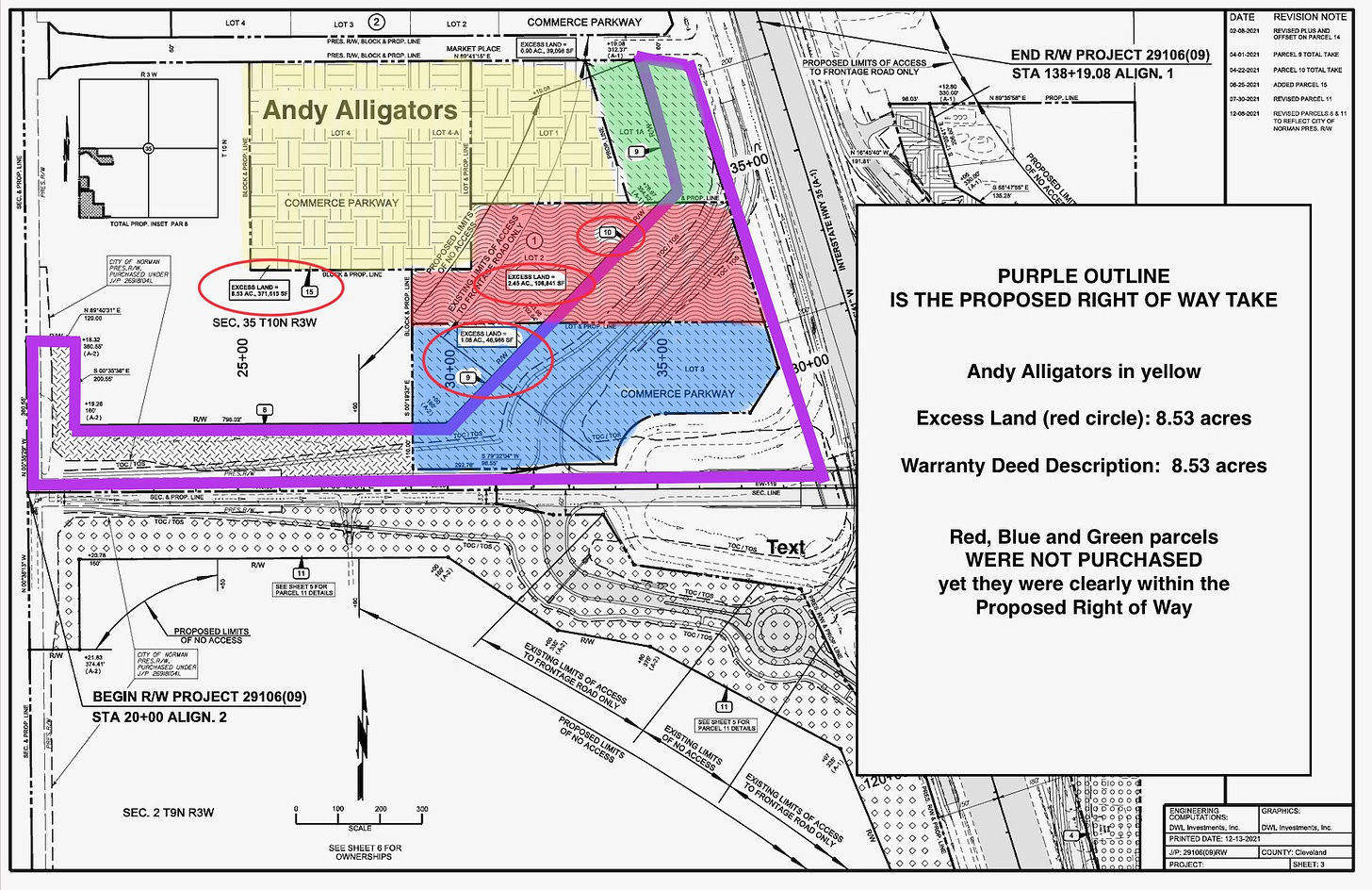
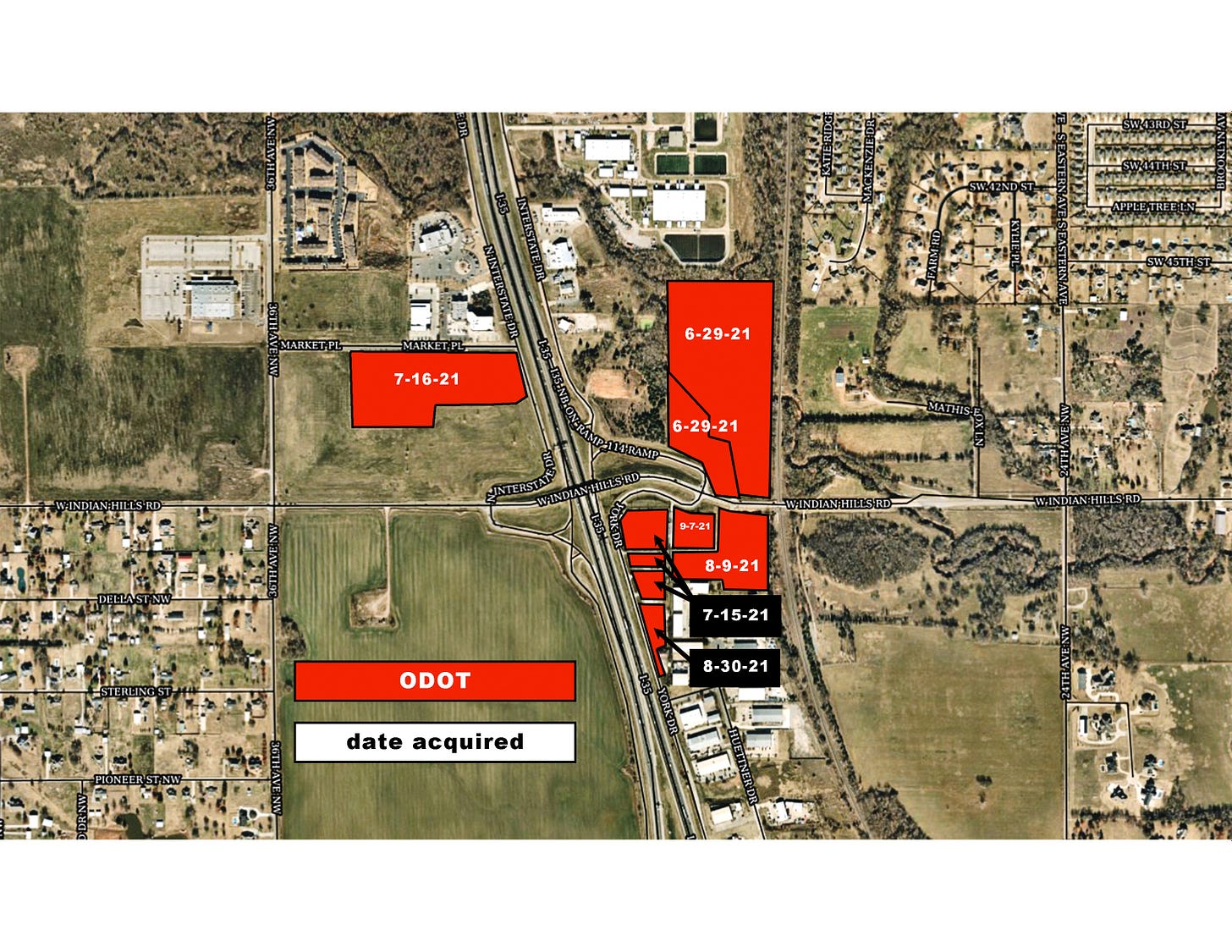


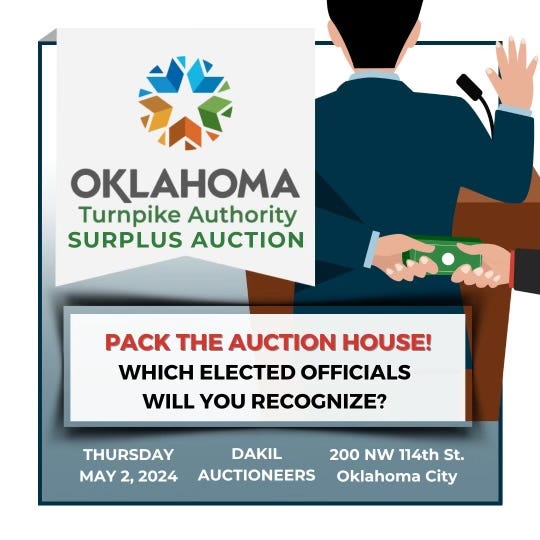
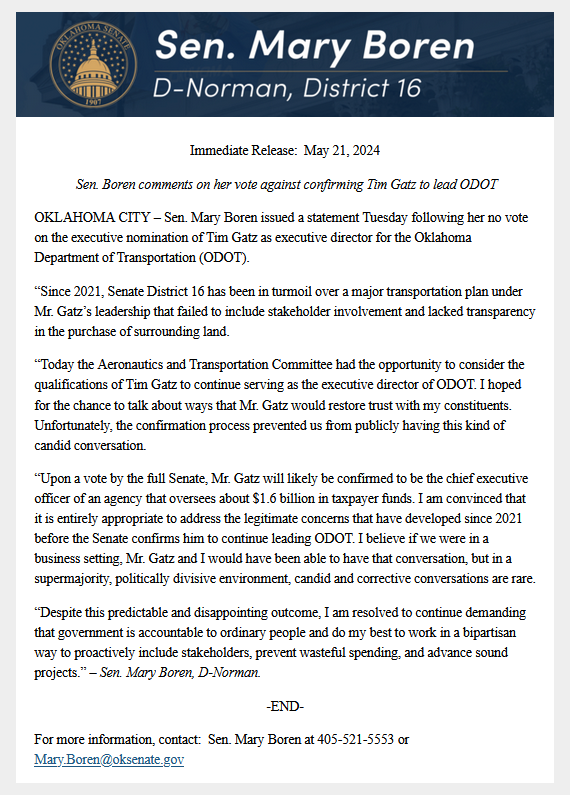

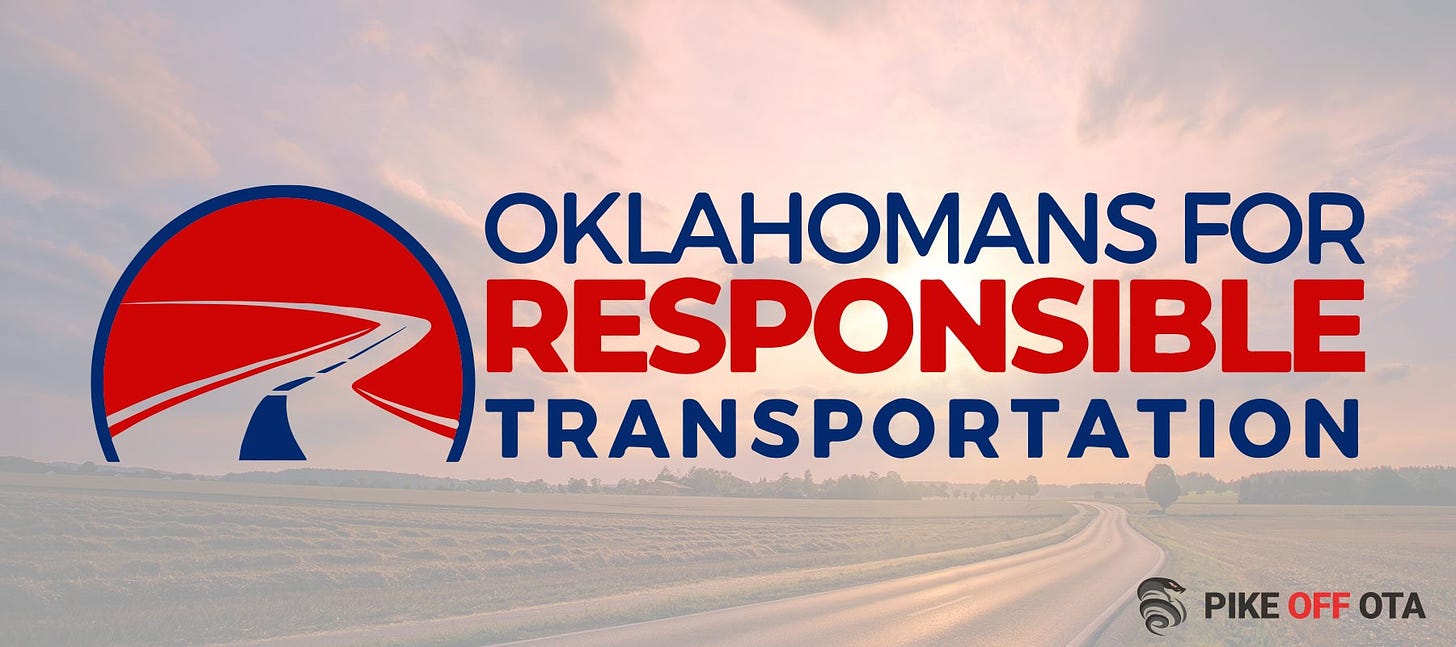
Thank you, Dr. Cerato and Senator Boren, for your honest effort to ask these tough question in an attempt to get honest answers. The sucking noise you heard as you left the room was the drop in intelligence and integrity that was left in the void.
Senator Boren's Leadership and Tim Gatz the Crony Operative
[Oklahoma's Executive Nomination Crisis: Exposing the Endless Cycle of Corruption]
NOTE: This is a piece I authored for the No More Oklahoma Turnpikes! Facebook group. I live in Norman, Oklahoma west of where the Oklahoma Turnpike Authority is abusing eminent domain powers to serve developer interests with new Turnpikes through what is currently rural property. I am not directed affected in this case; however, are we not all affected by government abuse of certain powers?
First, as the President of Passenger Rail Oklahoma, I would like to thank Senator Boren and Amy Cerato for reviving some of my faith in our democratic-republic. While critically wounded, it is not dead yet.
Full disclosure, my personal property is not 'yet' threatened by the Oklahoma Turnpike Authority (OTA), Oklahoma Department of Transportation (ODOT), or the Secretary of Transportation. (I guess the Governor has yet to replace [Tim] Gatz as secretary?) However, this does not mean I am unaffected. All of Oklahomans are affected in some manner simply due to rampant state government cronyism.
Cronyism at ODOT, as highlighted in Amy's piece, directly affected our long term effort to get ODOT to follow the law. This law is the Oklahoma Tourism and Passenger Rail Act of 1996 (Title 66, Section 321-325).
More specifically, the act, still on the books, requires ODOT to do all things necessary to link stations in Tulsa and Oklahoma counties with points on the national passenger rail network. Another long-retired state senator, Dave Herbert authored the legislation.
In 2013, one of Gatz’s predecessors, the late-Gary Ridley who was then ODOT Director, placed a 97.5-mile rail route between Del City and Sapulpa up for sale. The state purchased the line in 1998 to fulfill the intent of the 1996 law. If you were a crony like Ridley, Gatz, Mike Patterson, David Streb, Neil McCaleb or even [U.S. Representative] Tom Cole what would you do?
In 2013 Ridley placed the line up for sale at the request of the BNSF Railway. He understood we were getting close to achieving Senator Herbert's vision and that of my predecessors - probably the most effective being Tom Elmore.
Despite many too-little, too-late attempts by the legislature, the Oklahoma Transportation Commission allowed the sale to proceed. The Stillwater Central Railroad shortline won the bidding war.
Gatz though only told half of the story in his testimony. Are you surprised? The legislature and Governor Fallin spent the majority of the $75 million proceeds from the sale to in part fill a state budget failure that resulted from too many tax cuts.
Today, the Oklahoma City - Tulsa passenger rail project is effectively dead. The Oklahoma City - Newton, Kansas Heartland Flyer expansion project in critical condition, although that was never a well conceived plan in the first place. These failures result from a legacy of governors and state legislators confirming state transportation officials who not just ignore the law but work against it to serve the Oklahoma Infrastructure Cult.
I assume the vast majority of the current class of term-limited state legislators are unaware that the 1996 law exists. Senator Boren is not one of these. In fact we had a long discussion on the phone just after Attorney General Gentner Drummond's decision regarding an individual holding multiple positions in state government.
Regardless of your position concerning passenger rail development, you cannot argue that the state is ignoring the law... this is both the legislature as a governing body and ODOT. How deep does this go?
In the end, I am not as disappointed with the state agencies, the legislature, the governor, and Oklahoma congressional delegation as I am with the people of the state. We all share in neglect of our democratic-republic. We do not do not vet candidates before elections. We do not hold those elected accountable to uphold the law.
We have to do better or the electorate will continue to be a pawn for those who stand to gain financially from the status quo.
Evan Stair
President
Passenger Rail Oklahoma